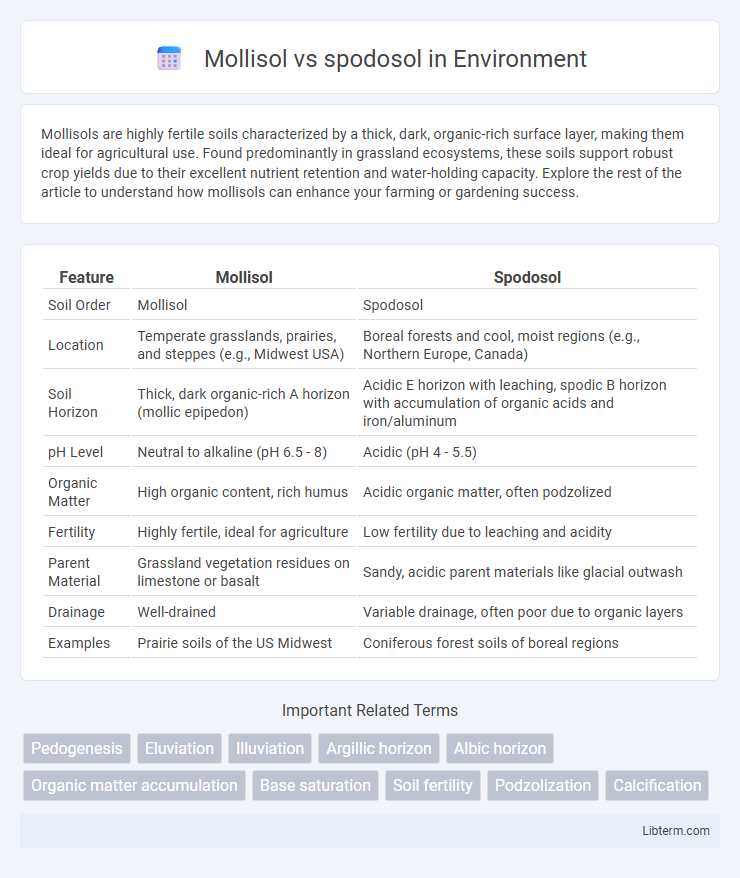Mollisols are highly fertile soils characterized by a thick, dark, organic-rich surface layer, making them ideal for agricultural use. Found predominantly in grassland ecosystems, these soils support robust crop yields due to their excellent nutrient retention and water-holding capacity. Explore the rest of the article to understand how mollisols can enhance your farming or gardening success.
Table of Comparison
| Feature | Mollisol | Spodosol |
|---|---|---|
| Soil Order | Mollisol | Spodosol |
| Location | Temperate grasslands, prairies, and steppes (e.g., Midwest USA) | Boreal forests and cool, moist regions (e.g., Northern Europe, Canada) |
| Soil Horizon | Thick, dark organic-rich A horizon (mollic epipedon) | Acidic E horizon with leaching, spodic B horizon with accumulation of organic acids and iron/aluminum |
| pH Level | Neutral to alkaline (pH 6.5 - 8) | Acidic (pH 4 - 5.5) |
| Organic Matter | High organic content, rich humus | Acidic organic matter, often podzolized |
| Fertility | Highly fertile, ideal for agriculture | Low fertility due to leaching and acidity |
| Parent Material | Grassland vegetation residues on limestone or basalt | Sandy, acidic parent materials like glacial outwash |
| Drainage | Well-drained | Variable drainage, often poor due to organic layers |
| Examples | Prairie soils of the US Midwest | Coniferous forest soils of boreal regions |
Introduction to Mollisols and Spodosols
Mollisols are nutrient-rich soils characterized by a thick, dark, organic-rich surface horizon known as the mollic epipedon, commonly found in temperate grassland regions. Spodosols have a distinctive subsurface accumulation of organic matter, aluminum, and iron, forming a spodic horizon, typically developing under coniferous forests in cool, moist climates. These contrasting soil orders reveal fundamental differences in formation processes, organic matter content, and vegetation associations.
Formation and Geological Origins
Mollisols primarily form in temperate grassland environments where organic matter from dense root systems accumulates, resulting in a thick, dark, nutrient-rich A horizon. Spodosols develop in cooler, humid regions with coniferous forests, characterized by acidic conditions that promote the leaching of iron, aluminum, and organic compounds into a distinct spodic horizon. Geological origins of Mollisols trace back to loess or glacial deposits rich in base cations, while Spodosols often originate from sandy parent materials influenced by podzolization processes under acidic, well-drained conditions.
Key Physical Characteristics
Mollisols are characterized by a thick, dark, nutrient-rich A horizon with high organic matter content, typically found in grassland ecosystems, and exhibit a granular structure with good moisture retention. Spodosols display a distinct eluvial (E) horizon beneath a thin organic layer, with an accumulation of iron and aluminum oxides in the spodic (B) horizon, resulting in acidic, sandy soils common in coniferous forest regions. The key physical difference lies in Mollisols' fertile, soft, and well-aggregated texture versus Spodosols' coarse, acidic, and leached profile with a clear horizon differentiation.
Chemical Properties Comparison
Mollisols exhibit high organic matter content and alkaline pH, leading to elevated base saturation and nutrient-rich profiles, especially calcium and magnesium. In contrast, Spodosols are acidic with low base saturation due to leaching of cations, resulting in accumulation of iron and aluminum oxides in the subsoil. The chemical properties of Mollisols support high fertility, while Spodosols have limited nutrient availability and require amendments for agriculture.
Geographic Distribution
Mollisols predominantly occur in the central grasslands of North America, particularly in the U.S. Midwest and Canadian Prairies, supporting extensive agricultural activities due to their fertile, organic-rich topsoil. Spodosols are commonly found in cool, moist regions with coniferous forests, such as the northeastern United States, parts of Canada, and northern Europe, where acidic conditions lead to leaching and podzolization. The geographic distribution of these soil orders reflects their adaptation to distinct climatic and vegetative zones, influencing land use and ecosystem characteristics.
Typical Vegetation and Ecosystems
Mollisols support tallgrass prairies and fertile grassland ecosystems characterized by deep-rooted grasses well-adapted to nutrient-rich, organic matter-rich soils. Spodosols are commonly found under coniferous forests, especially boreal and temperate needleleaf woodlands, where acidic litter promotes podzolization and limits nutrient availability. These contrasting soil types influence vegetation structure and biodiversity, with Mollisols facilitating productive agricultural lands while Spodosols sustain acidic forest ecosystems.
Agricultural Suitability
Mollisols are highly fertile soils with a thick, dark organic-rich surface horizon, making them ideal for agriculture, particularly for growing cereal grains and legumes. Spodosols, characterized by acidic, sandy textures and low nutrient availability, are less suitable for intensive farming and require significant amendment for crop production. The superior nutrient-holding capacity and pH balance of Mollisols enhance crop yield potentials, unlike the nutrient-poor, acidic conditions of Spodosols.
Soil Management Practices
Mollisols, characterized by high organic matter and fertility, require conservation tillage and crop rotation to maintain soil structure and nutrient availability. Spodosols, with acidic and sandy profiles, benefit from liming to adjust pH and the addition of organic amendments to enhance microbial activity and nutrient retention. Effective soil management practices tailored to these distinct soil orders optimize crop productivity and sustainable land use.
Environmental Impacts
Mollisols, characterized by thick, nutrient-rich topsoil, support high agricultural productivity but can lead to significant environmental impacts such as soil erosion and nutrient runoff when improperly managed. Spodosols, typically found in acidic, forested regions, have low natural fertility and organic matter accumulation, which limits their agricultural use but helps preserve native ecosystems and reduce soil degradation. The contrasting environmental impacts of Mollisols and Spodosols highlight the importance of sustainable land management practices tailored to each soil type's characteristics.
Summary: Choosing Between Mollisols and Spodosols
Mollisols feature nutrient-rich, dark organic layers ideal for agriculture due to their high base saturation and fertile topsoil, whereas Spodosols possess acidic, sandy soils with distinct spodic horizons, limiting their agricultural use but supporting coniferous forest ecosystems. Selecting between Mollisols and Spodosols depends on intended land use: crop production favors Mollisols while Spodosols suit forestry or natural preserves. Understanding soil properties like pH, organic content, and mineral composition guides effective land management and sustainable utilization.
Mollisol Infographic

 libterm.com
libterm.com